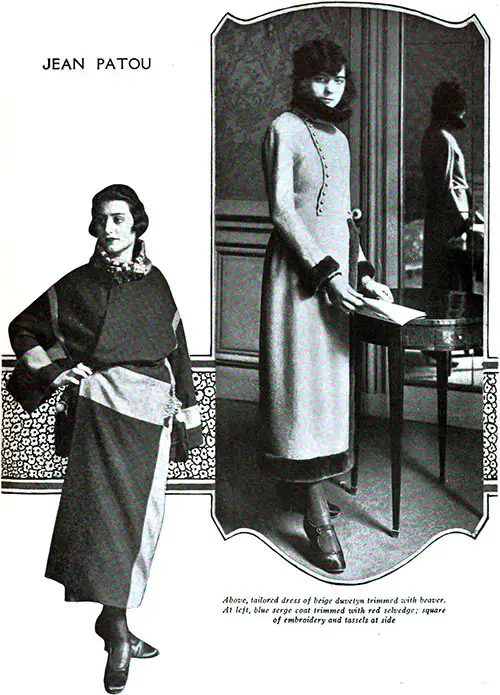Jean Patou - Parisian Fashion Designer - 1920

Above, tailored dress of beige duvetyn trimmed with beaver.
At left, blue serge coat trimmed with red selvedge, square of embroidery and tassels at side
Straight, Clinging Outline Consistently Followed by This House in Practically All Models Charming Effects Achieved by Touches of Color
Jean Patou has but lately established himself in the rue Saint Florentin with the firm intention of succeeding. His extraordinary capabilities, both as manager and creator of models, have been proven by an ever-increasing stream of American buyers.
The collection of M. Patou presents a very curious trait: it is perfectly consistent, giving the same line from tailleurs to evening dresses. This is one of the first houses that adopted the straight, clinging outline, now definitely the winter fashion.
For that very uniformity of style, this “opening” is a delicate one to write about; it is full of subtle touches and sly little innovations in trimmings without eccentricities or extravagances, so much more easily described.
We may begin with traveling coats all snug and business-like: tweeds, kashavella, mouflonne in browns, with a fair sprinkling of plaids, make good, straight coats, not very ample, shirred or fitted-in slightly at the waist, with high collars and roomy sleeves.
Big pockets stitched heavily in silk are the only trimming of a beige kashavella; a green plaid coat has a big, round cape lined with plain green cloth. The new stuff, Pelissa, like a thick plush or a tremendously rugged melton, makes good wraps.
The success of the day went to a coat made of the new shawl stuff I have described elsewhere. A bright selvage edges immense woolen squares with yet a different color at the corners.
A straight mantle made of two dark blue squares edged in bright blue has the selvages at the sides; the intersection square occurs just at the hips, is wool embroidered and weighted down by a huge tassel. Another model has an interesting collar of natural white and brown skunk, striped.
Tailleurs, no matter what the length of the coat, are straight and rather plain. One departure from the rule of high collars is a little black serge bound in narrow black braid; the medium-length coat made like a man's smoking jacket.
Duvetyn is used both for tailored and one-piece suits; plaids are popular allied to a plain stuff and velvets strike a dominant note. Although monkey has not the vogue it previously enjoyed, it is used persistently on a model or two by every house, principally as fringe.
The tunic skirt, that is, the skirt wound flatly around the wearer and ending off irregularly to one side, is well carried out here; pointed side panels and detached strips are frequent.
The many plaid dresses deserve description. First, this fancy stuff as the foundation of a blue serge coat dress, fastening up one side from collar to waist and thence open, revealing the cheerful highland underneath.
On the same order is a gay morning suit of blue and yellow plaid, with a monkey collar worn over a striped yellow lining.
Two breadths of stuff give the best straight effect split up the sides over a contrasting lining; where the material is heavy, it falls of itself; with flimsy fabrics, it is thought more graceful to turn the panels in at the hem: hence the numerous but varied specimens we meet in every collection of this graceful style. A blue serge over black satin is sparingly embroidered in triangular motifs of Arab work of bright blue and silver at the sleeves and shoulders.
Embroidery, silk or wool, is minute and fine; all-colored wools on blue is charming and ton-sur-ton carpet-like arabesques give body to lightweight stuffs.
The simple, elegant afternoon gowns have round necks and short sleeves, the turned-in hem almost invariably a feature; one of these, a mouse charmeuse, escapes monotony by being much shirred and slit up the sides at intervals showing a Nattier lining where it is not concealed by orange, waxed satin ribbons.
Soft old-blue is trimmed with yellow ribbons; a royal blue velvet has a blue lamé sash and opens over a similar vest; still, another pale blue brocade (to show you how popular the color is) has a deep yoke, sleeves, and hem formed by the faithful tracing over of the design in red and gray silk.
Dinner dresses, according to the favorite Parisian custom, are black over black or combined with gold or silver. The long-waisted bodices are often crossed or quite high with the straight shoulder lines; detached loops of uneven lengths, caught in or not at the hem, and at any rate a good deal longer, give the popular line; lace aprons occur several times; a black satin has one of net traced closely in emerald silk, the sides folded over and forming the least hint of a drapery.
For the evening where gold-shot lamés are plentiful, the Turkish trouser effect given by the shirred-in hem goes very well with this beautiful oriental stuff.
We have plenty of trains, classical and otherwise; otherwise is the case of a pink and silver worn over silver lace; the lamé divides in the back into two long panels of unequal lengths, caught together and knotted at the feet to form a single train.
There are few draped dresses, but a good many velvet ones, the skirt cut into panels much embroidered, combined with silk muslin or that newcomer, thick silk fringe.
"Jean Patou" in the Garment Manufacturers’ Index, New York: The Allen-Nugent Co. Publishers, Vol. II, No. 3, October 1920: 24-25.
